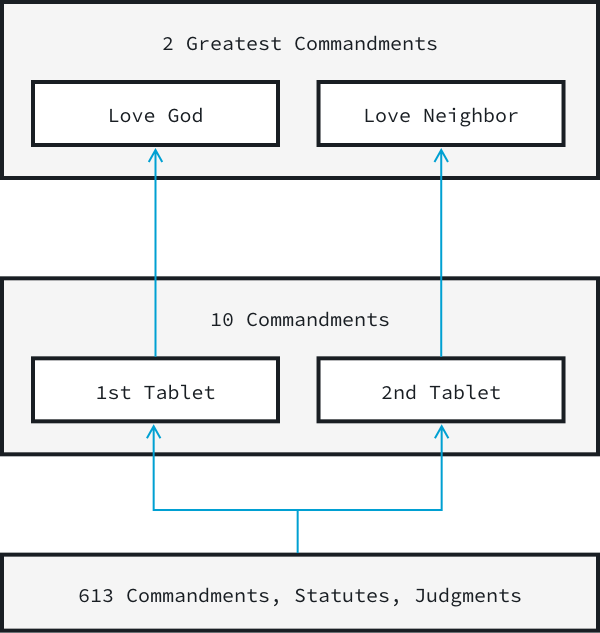And he gave unto Moses, when he had made an end of communing with him upon mount Sinai, two tables of testimony, tables of stone, written with the finger of God.
Exodus 31:18 (KJV)
Two tables of testimony – The 10 commandments are amazing. They were written by the finger of God on two tablets of stone. The legend is that the stone was made of sapphire, the tablets were cut from a perfect cube measuring 18″ x 18″ x 18″, and that cube was split in half so that each of the commandments was 18″ tall by 18″ wide and 9″ thick. The writing from God was said to have gone all the way through the stone so that if one looked at it, you could see through the other side. But if you flipped the tablet over, it didn’t show the text in reverse as one might imagine, but showed the text the same as the front.
According as his divine power hath given unto us all things that pertain unto life and godliness, through the knowledge of him that hath called us to glory and virtue: (2 Peter 1:3)
They were miraculous wonders created by the divine power of God.
It doesn’t stop there. I’d like to connect the various relationships found in the 10 commandments by revealing 3 levels of structure therein.
1st Structure
The relationship of the two tablets to the other laws.
The two greatest commandments are; Love God (Deuteronomy 6:5) and Love your neighbor (Leviticus 19:18, 34). Yeshua wasn’t making these commandments up in Matthew 22:36-39, He was simply revealing something that was already written in the law.
Each of these two commandments are directly supported by the 10 commandments. And each of the 10 commandments are supported by the 613 commandments, statutes, and judgments. It’s all related.

Every law will work this way. As an example, I was recently asked, how does the law forbidding the consumption of fat work here? (Leviticus 3:17) If we run it up the ladder, which of the 10 commandments does it support? Think about it a bit. What does God say about the fat of an animal? Leviticus 3:16. Well if the fat is God’s property, then eating it would be stealing from God. This supports the law, thou shalt not steal. And thou shalt not steal in this regard, since it’s directed toward God, supports the greatest commandment of loving God. You see how these work together?
2nd Structure
The relationship of the two tablets, horizontally.
The 2nd structure has to do with the commandment’s relationship from one tablet horizontally with the other.

1st <—> 6th
| 1st Commandment I am the Lord your God, no other gods. |
6th Commandment Do not murder. |
We know that murdering a human being is wrong. And we also know that man is created in the image of God. (Genesis 9:6)
When murder happens, we’re murdering someone that was created in the image of God. Here we are commanded to recognize God and to agree that there are no other gods like Him. At that same time, we should recognize our brother as created in the image of God, and there is no other human being like him.
So why do people murder? Perhaps they think their life will be better without that person in the world. Well how does this relate to the Creator? Perhaps people think their life might be better without God in the world. But they can’t murder God. So what do they do? They ignore Him.
So what’s the relationship between MURDER and IGNORING someone? They are two different ways of getting rid of someone.
Murder is concrete.
Ignoring is abstract.
They are really the same thing. When we desire to not have someone around whether that’s another person or God, the principle here is don’t try to get rid of them, but instead recognize them.
PRINCIPLE: Don’t do away with others.
2nd <—> 7th
| 2nd Commandment Do not make graven images. |
7th Commandment Do not commit adultery. |
We know that adultery is wrong. Don’t interfere with the marriage of another man and woman. And we know that idolatry is wrong too. Don’t have something that interferes in our relationship with God.
Marriage – horizontal relationship
Worship – vertical relationship
When there is a horizontal relationship, like marriage, we shouldn’t allow anything to come between that. No adultery.
When there is a vertical relationship, like worship, we shouldn’t allow anything to come between that. No idols.
PRINCIPLE: Don’t betray relationships.
3rd <—> 8th
| 3rd Commandment Do not take Lord’s name in vain. |
8th Commandment Do not steal. |
When we think of stealing today, we think about stealing inanimate things (gum, toys, food, etc.) but during the ancient times it was also related to kidnapping or stealing livestock.
So how does stealing a body relate to taking God’s name in vain?
The word “take” from “don’t take God’s name in vain” in the Hebrew can mean “lift up” or “carry off.” It alludes to picking up and carrying away God’s name — as if God’s name was a thing.
How would we feel if someone stole something from us? Often times the people interviewed say they feel “violated.” It’s interesting that someone can feel violated by the stealing of their precious things.
Let’s look at kidnapping. In a sense kidnapping is stealing your body. Our body is one of our most precious things. We even express our bodies as something we own by saying “My body.” It’s our self expression in the world.
Well God doesn’t have a body — He has a name. His name is His self expression in our world. What’s His name? YHVH
Name is abstract self-expression.
Body is a concrete self-expression.
PRINCIPLE: Don’t violate abstract/concrete self.
4th <—> 9th
| 4th Commandment Remember the Sabbath and keep it holy. |
9th Commandment Do not bear false witness. |
Keeping the Sabbath is an act of testimony. We’re recognizing that God created everything in 6 days and on the 7th He rested. In a sense, keeping the Sabbath is a testimony that God is the Creator of everything.
We also give testimony in court. These are often times about another person — our horizontal relationships. Do you see that keeping the Sabbath in our vertical relationship with God is a testimony to His creation. Giving testimony about our neighbor should also be true.
If we don’t tell the truth about someone’s actions we lie about them. It’s kind of like identity theft. It’s attacking someone’s reputation.
If we don’t keep the Sabbath, we’re denying God’s truth as the Creator of the universe. If we bear false witness of our neighbor, we’re denying the truth about our neighbor.
PRINCIPLE: Safeguard the truth.
5th <—> 10th
| 5th Commandment Honor father and mother. |
10th Commandment Do not covet. |
This is probably the most difficult relationship to see. Somehow in what we’re studying, there should be a relationship between honoring our father and mother and not coveting.
Why is it that people covet? It’s interesting that the commandment doesn’t just say “don’t covet” but it goes on and on about not coveting this of your neighbor’s or that. Why?
Essentially what people want when they covet is to be that other person. If they have all these things that the other person has, maybe somehow they’d be that other person.
So now think about honoring your parents? They’ve given you everything; your life, your education, your things. But what if you felt like what they gave wasn’t good enough? You’d be resentful.
What we’re seeing here is that honoring your parents is respecting the life they gave you. It’s being satisfied with what you have. It’s understanding that you are a product of their making. You don’t need to covet and try to have someone else’s life.
PRINCIPLE: Don’t do away with self.
Let’s review them all together.
| Vertical Relationship 1st tablet |
Horizontal Relationship 2nd tablet |
Principle |
|---|---|---|
| I am the Lord your God, no other gods before me. | Do not murder. | Don’t do away with others. |
| No graven images. | Do not commit adultery. | Don’t betray relationships. |
| Do not take the LORD’s name in vain. | Do not steal. | Don’t violate abstract/concrete self. |
| Remember the Sabbath and keep it holy. | Do not bear false witness. | Safeguard the truth. |
| Honor your father and mother. | Do not covet. | Don’t do away with self, don’t try to be something else. |
Now there’s still one more structure found.
3rd Structure
The relationship of the principles, vertically.
- Don’t do away with others.
- Don’t betray relationships.
- Don’t violate abstract/concrete self.
- Safeguard the truth.
- Don’t do away with self.

The 10 commandments begin with the principle, “Don’t do away with others.” and end with “Don’t do away with self.”
The first 4 principles talk about not violating another person or God.
- Another entity (God or person)
- Don’t violate a person’s body
- Don’t violate relationships
- Don’t violate possessions
- Don’t violate reputation
And the last principle points back to you.
- Don’t violate SELF
It’s about your self-esteem. If you love God, then there is an inherent self-esteem that comes with that. You recognize that you have a purpose. You are created for something. You have a God that thinks about you and loves you! And if you have all this, your self-esteem should be positive. Nothing can tear you from the love of Jesus! (Romans 8:35-39)
And with this same self-esteem, we’re commanded: Love your neighbor as you love yourself.
LOVE
Our vertical relationship with God is similar to our horizontal relationships with our community.
A negative way to look at our vertical relationships is to look at God as a thing that benefits us. We could pray to Him for things that make our lives special. We can look at our horizontal relationships this way too. Take from the community to benefit ourselves. Maybe we only socialize with the “in” crowd, maybe we look for validation from others to push our pride further, etc.
BUT
If we’re willing to serve God and sacrifice our lives for Him, this can be reflected in our horizontal relationships as well. Are we willing to serve our brothers and sisters and sacrifice our lives for them? This is love. (John 15:13)
This lesson was given for a week-long VBS class in 2018.

Leave a Reply